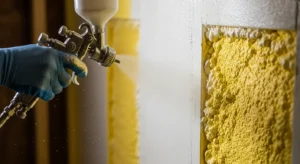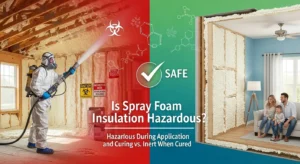Have you ever felt cold air sneak into your house in the winter? Or maybe your air conditioner works hard in summer, but the house still feels warm. One reason could be that your home isn’t insulated well. Insulation helps keep homes warm in the winter and cool in the summer. In this article, we will explore spray foam insulation types in detail.
Spray Foam Insulation Types: Open Cell and Closed Cell
There are two main types of spray foam insulation:
- Open-cell spray foam
- Closed-cell spray foam
They may seem similar, but they have important differences. Let’s look at each one to understand how they work and which one might be better for your home.
Open Cell Spray Foam
What Is It?
Open cell spray foam is soft and squishy. When it dries, it stays kind of spongy. The foam has tiny bubbles or “cells” that are not fully closed. This means air can fill these spaces inside the foam.
Key Features
- Lightweight: Open cell foam is not heavy. It weighs less than closed cell foam.
- Expands a lot: It can grow up to 100 times its size after being sprayed. This makes it great for filling large spaces.
- Soft texture: When you touch it, it feels like a sponge or cushion.
- Good soundproofing: It helps block sound, so it’s great in walls where you want quiet.
Where Is It Used?
Open cell spray foam is often used:
- Inside walls
- In attics
- Around pipes and wiring
- In ceilings
It’s a great choice for indoor areas where water isn’t a big problem.
Pros of Open Cell Foam
- Less expensive than closed cell
- Excellent sound barrier
- Fills small spaces easily
- Flexible and soft, which helps during house movement
Cons of Open Cell Foam
- Not waterproof
- Lower insulation power (called R-value)
- Not as strong as closed cell foam
Closed Cell Spray Foam
What Is It?
Closed cell spray foam is very different. It has bubbles or “cells” that are all sealed shut. These tiny cells are packed tightly, and no air can get inside them.
This makes the foam very dense and hard. It’s strong and acts like a barrier against air and water.
Key Features
- Very dense: Closed cell foam is thick and firm.
- High R-value: This foam keeps heat and cold out very well.
- Strong and rigid: Once it dries, it adds strength to walls or ceilings.
- Water-resistant: It does not let water pass through.
Where Is It Used?
Closed cell spray foam is often used:
- In basements
- On exterior walls
- On roofs
- In metal buildings
- In areas with high moisture
It’s perfect for places where water or extra strength is a concern.
Pros of Closed Cell Foam
- Excellent insulation
- Water-resistant
- Adds structure strength
- Lasts a long time
Cons of Closed Cell Foam
- More expensive than open cell
- Harder to apply in tight spaces
- Less soundproofing than open cell
- Not breathable (no airflow through it)
Comparing the Two: Which One Is Better?
There is no “best” spray foam for every home. The right type depends on where it is used and what you need. Here is a simple comparison:
| Feature | Open Cell Foam | Closed Cell Foam |
| Texture | Soft and spongy | Hard and dense |
| R-Value (insulation power) | Lower (about 3.5 per inch) | Higher (up to 7 per inch) |
| Cost | Less expensive | More expensive |
| Soundproofing | Better at blocking noise | Not as good |
| Water Resistance | Not waterproof | Waterproof |
| Expansion | Expands a lot | Expands a little |
| Strength | Less strong | Very strong |
When to Use Open Cell Foam?
Use open cell spray foam when:
- You want to save money
- You want to block sound between rooms
- The area is inside the house and dry
- You need to fill large or odd-shaped spaces
When to Use Closed-Cell Foam?
Use closed-cell spray foam when:
- You need a strong barrier against water
- You are insulating outside walls or basements
- You want the highest insulation value
- You want to add strength to your walls or roof
Safety and the Environment
Both types of spray foam are safe when used the right way. It’s best to let a trained professional install it, because the chemicals can be harmful before they dry. Once dry, the foam is safe and long-lasting.
Some spray foams also come in “green” versions. These use eco-friendly materials and create less pollution. Ask your contractor about using low VOC or water-blown foam to help the environment.
Need Spray Foam Insulation Services? Reach Out to Air Seal Insulation
Need spray foam insulation services? Trust Air Seal Insulation for top-quality results. We offer energy-efficient, reliable insulation solutions for homes and businesses. Our expert team ensures proper sealing, comfort, and savings. Reach out today for a free estimate and experience the difference of professional spray foam insulation. Stay warm, stay efficient!




